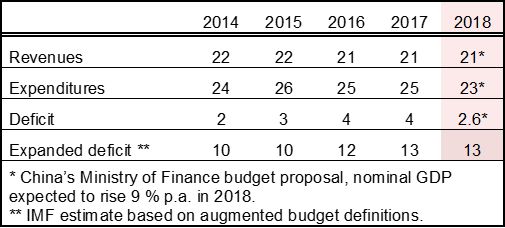BOFIT Weekly Review 10/2018
Assessing true condition of China's public sector finances remains challenging
Under the draft proposal presented to the NPC, the combined deficit of China's central and local government budgets this year will amount to 2.6 % of GDP. Last year's 3 % deficit target was exceeded by about one percentage point, as actual spending exceeded budget.
This year's budget reflects the policy lines formulated in the autumn. Spending will be boosted for poverty eradication and environmental protection. Defence spending and the larger spending category of domestic security will increase faster than the budget overall. Budget revenues should match nominal GDP growth (9 %), while spending will lag slightly.
The IMF notes that China's local governments have been burdened with some of the world's heaviest spending obligations – without much possibility to influence revenue streams. Partly for this reason, local governments have had to constantly increase their debt loads, only part of which is visible in official budget statements. A reform plan published in 2016 was intended specifically to address this revenue and spending imbalance.
Whatever is happening China's public sector finances is difficult for outsiders to decipher. Chinese budget figures are not comparable to those of other large economies. The IMF's own estimate of public sector finances in 2016 was: 28 % of GDP for revenue, 32 % of GDP for spending and nearly 4 % of GDP for deficit. When off-budget activities of local governments are included, the IMF, using a wider definition of deficit, finds that the 2016 deficit was as high as 12 % of GDP.
Combined central and local government budget, % of GDP

Sources: China's budget report 2017–2018, IMF and Macrobond.